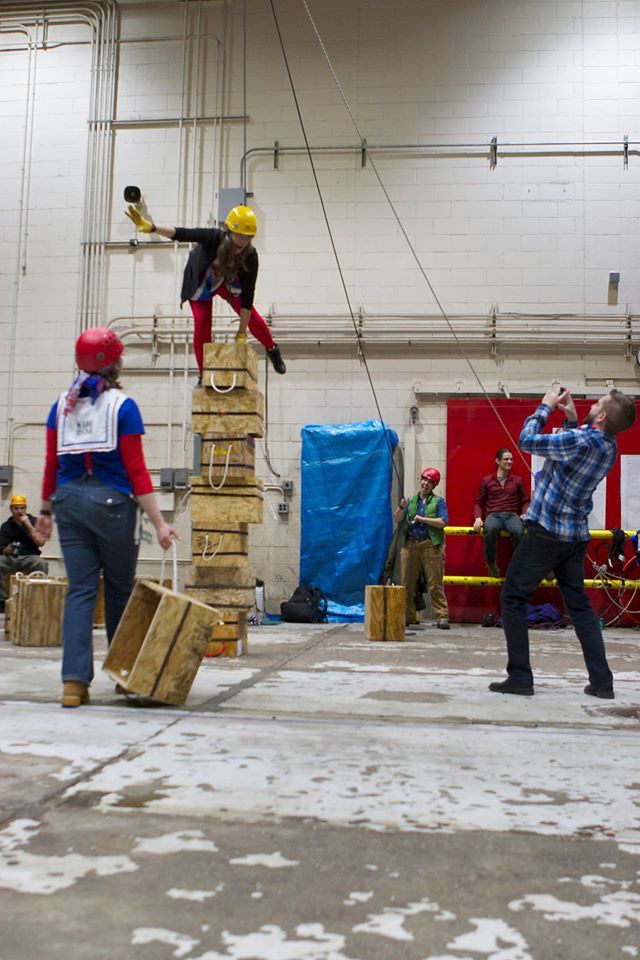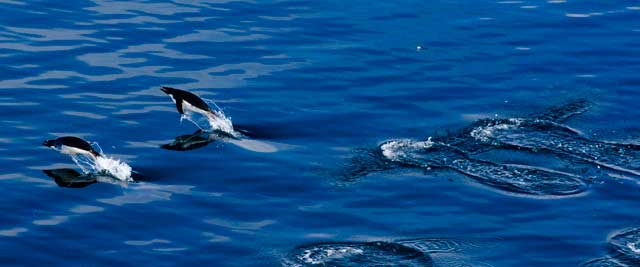|
McMurdo Station Archives - 2014 Science season in full swing as field camps fill upDecember 11, 2014
The stormy weather of October was mostly a distant memory in November, as skies cleared and scientists spread away from McMurdo Station into the hinterland of Antarctica to conduct research at nearby valleys, ice shelves and glaciers. By the end of November, there were more than 250 scientists deployed for the U.S. Antarctic Program, with about 40 groups on the Ice and 20 field camps in operation. Of course, favorable weather in McMurdo doesn’t mean the sun is shining everywhere on a continent the size of the United States and Mexico combined. 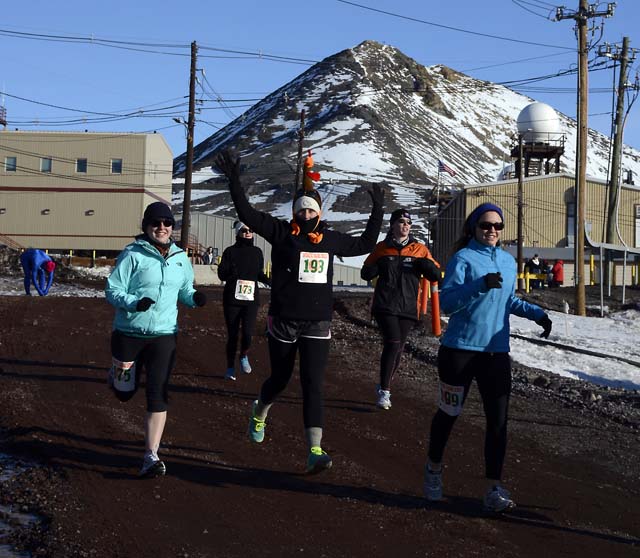
Photo Credit: Peter Rejcek
Runners participate in a special edition of the McMurdo Turkey Trot for nightshift workers.
For instance, due to weather and some mechanical issues with aircraft, it took 11 days for the first flights to reach the WAIS Divide field camp in West Antarctica, where a number of research groups will send instruments down a hole in the ice nearly two miles deep. The borehole was the result of a years-long effort to extract an ice core for research on past climate. Many of the projects this year will use the borehole to further those studies. Initial flights to Amundsen-Scott South Pole Station from McMurdo also got off to a slow start, with the first LC-130 flight arriving about a week later than scheduled on Nov. 6. However, by the end of the month, the population at Pole maxed out at 151 people. The population at the world’s southernmost research base was also augmented by nine members of the South Pole operations Traverse (SPoT), a tractor train that moves fuel from McMurdo to South Pole across a thousand miles of ice and snow. The team arrived just in time for the Thanksgiving holiday, which included 11 turkeys, 75 pounds of potatoes and 12 loaves-worth of stuffing – not mention about 30 pies of the apple, pecan and pumpkin variety. Thanksgiving back at McMurdo Station was also a grand affair, beginning with a 5K run called the Turkey Trot and ending with a party at the station’s Big Gym. Freezing Man, modeled after the alternative event Burning Man, featured a hip-hop dance group, hula hooping, and caricature portraits by painter Lily Simonson, who is at McMurdo Station as part of the National Science Foundation’s Artists and Writers Program. Several groups of distinguished visitors came through McMurdo in November. At the top of the list were three members of the National Science Board, the governing board for the National Science Foundation. The NSB members were accompanied by Candy Green, acting U.S. ambassador to New Zealand. The good weather temporarily came to an end during the last week of November, shutting down most helicopter operations and delaying some science projects, including a team of fossil hunters headed to an area called Allan Hills on the edge of the McMurdo Dry Valleys. The fossil-rich area offers a window into about 100 million years of geologic history, from the Permian into the Triassic. Still speaking of weather: November ended a three-month trend of above average temperatures based on a five-year average. Both August and September were eight degrees centigrade above normal high temperatures, while October was two degrees higher than average. However, November turned a cold cheek on McMurdo, with the average temperature four degrees centigrade colder compared against the monthly highs over the last five years. One of the big questions for McMurdo in December must include: Will there be a white Christmas? Only Father Time will tell. Stormy weather finally departs and main part of science season beginsNovember 13, 2014
McMurdo Station is finally emerging from a thick blanket of snow caused by a series of strong storms that brought precipitation and powerful winds through the area during much of October. Poor weather delayed a number of flights, postponing the start of some research projects and stranding upwards of a quarter-of-a-million pounds of cargo in Christchurch, New Zealand, at one point. A sudden spate of sunshine during the last week, however, finally brought the feel of summer (as summer-like as Antarctic can get) to Ross Island. It also gave support personnel at McMurdo time to catch up on work that had been impeded by the storms, many of which restricted outdoor travel due to near white-out conditions. 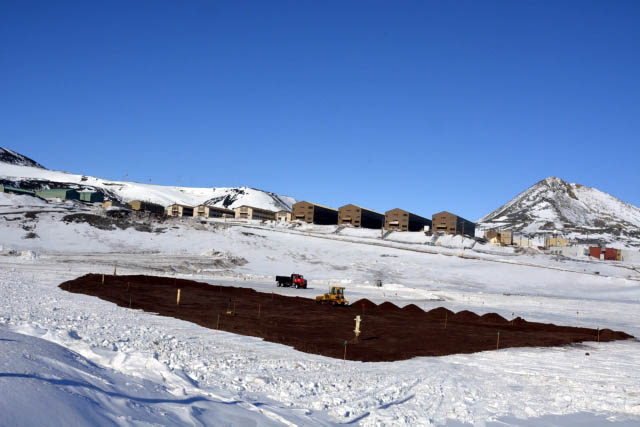
Photo Credit: Peter Rejcek
The return of clear skies to McMurdo Station has allowed personnel to catch up on tasking, such as spreading the top layer of dirt on the ice pier.
The preparation of Williams Field on the Ross Ice Shelf was one short-term casualty of the bad weather. This is the first time in several summers since it has been used as a primary airfield for ski-equipped airplanes, as most flight traffic had been handled out at Pegasus Airfield and the annual Sea Ice Runway. However, late-summer melt at Pegasus Airfield in the last two years has forced the U.S. Antarctic Program to shift back to Williams Field during part of the season. Another advantage to Williams Field is that it is only half the distance, about seven miles, to Ross Island compared to Pegasus, cutting down significantly on the slow ride along compacted snow roads. The re-opening of Williams Field required more work than just repairing the snow runways that had seen little use in recent years and setting up the infrastructure needed to run the airfield. The Long Duration Balloon facility – used to launch telescopes into the stratosphere on gigantic, helium-filled balloons – had to be relocated because it had occupied nearly the same air space as Williams Field. The storms that disrupted work at the airfield also slowed progress toward relocating and rebuilding LDB, as it’s known. However, the facility is coming together, and several science teams will launch their instruments more than 100,000 feet into the atmosphere later this year, studying everything from subatomic particles called neutrinos to the inflation of the early universe. 
Photo Credit: Peter Rejcek
Weddell Seals in McMurdo Sound are the subject of three separate projects this season.
McMurdo exists to support science, and much of the early research happens relatively close to the station on the sea ice that surrounds a large section of Ross Island’s coastline. The sea ice is home to a large breeding colony of Weddell seals, and three projects this year are focused on the world’s southernmost mammal. One project involves a long-term study that has been going on for more than 40 years, collecting data on the population dynamics of the Erebus Bay colony. A second study is focused on the timing of critical events – breeding and molting – in a seal’s life and how environmental changes could affect those outcomes. A third team of researchers is investigating whether seals use the Earth’s magnetic field to navigate under the sea ice when they hunt for prey. All sorts of wildlife – or at least approximations with varying degrees of success and silliness – could be found at the annual Halloween party at McMurdo. The first big party of the year is one of the most popular, complete with a costume contest that included a winning Mad Hatter and doppelgangers of some of the more noted McMurdo personages. Now, hopefully, the weather will continue to treat the station to sunny skies and not play any more nasty tricks involving snow and wind. McMurdo Station ready for summer field seasonOctober 17, 2014
At last report, McMurdo Station winter-overs were busily preparing for the WinFly season, which was scheduled to begin on Aug. 20. Much has happened since then. A period, generally in August, when several flights are sent to Antarctica to prepare the U.S. Antarctic Program for the summer field season, WinFly came in with a bang, starting with a string of storms that delayed the first flights by four days. Heavy snowfall and poor visibility buried the ice runway in snow, causing several days of extra work for on-site personnel to prepare for the first flights. Once flights were able to resume, the population increased from 142 to 331. The WinFly flights also brought 5,000 pounds of mail and copious amounts of fresh fruits and vegetables, causing great rejoicing amongst the winter-over population. 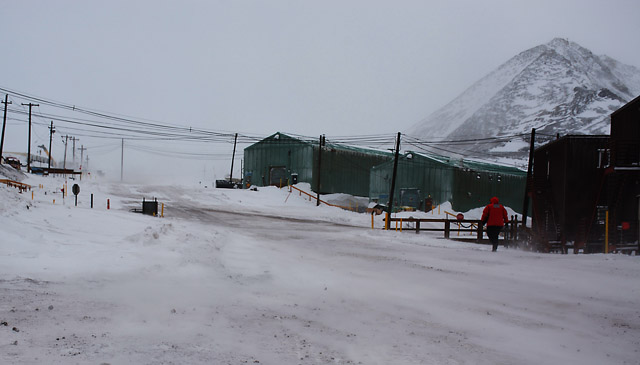
Photo Credit: Peter Rejcek
Weather at McMurdo Station has been snowy and windy more often than not, causing numerous flight delays.
For more than a month now, personnel at the Vehicle Maintenance Facility have worked tirelessly to prepare the extra vehicles that are needed to support the growing population while the maintenance staff brought buildings back online that had been left cold for the winter. Meanwhile, the Field Safety office has been busy conducting survival courses to prepare people to work in remote field camps in Antarctica. They also began flagging roads to summer science sites such as Cape Evans. Personnel are also preparing for a 60-mile tractor traverse across McMurdo Sound to carry equipment and supplies to Marble Point where a helicopter refueling station is located. Science support staff worked busily in the Crary Science and Engineering Center to prepare offices, labs and supplies for the incoming scientists who began arriving in early October. In addition, seawater pumps that supply water to the Crary aquarium were installed at the seawater intake on Sept. 15. A seven-mile-long fuel line was laid from near McMurdo Station to Williams Field on the Ross Ice Shelf. The hose will provide fuel for the ski-equipped LC-130s flown by the New York Air National Guard. The airfield has not been used regularly for flights since 2009-10 when most air operations shifted to Pegasus Airfield. However, melt issues at Pegasus in recent years has prompted a return to Williams Field for the latter half of the austral summer. 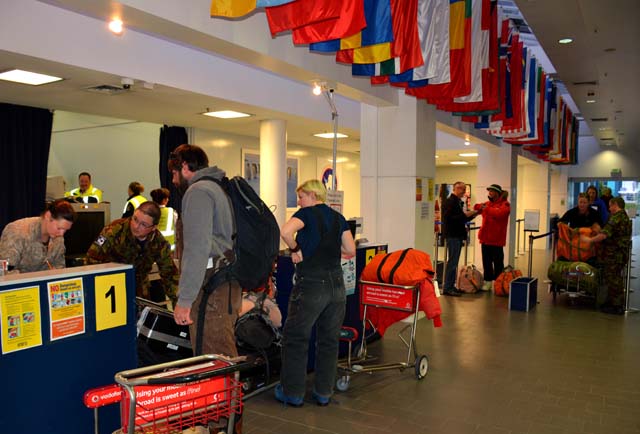
Photo Credit: Peter Rejcek
Support personnel and scientists check in for a flight to Antarctica from the USAP airport passenger terminal.
One major winter project that benefited greatly from the flights during WinFly was the remodel project taking place in one of the dormitories. Commonly referred to as “the 210 project” in reference to the dormitory’s building number, this was a complete interior renovation to reconfigure the rooms into smaller, single units. Construction of the new ice pier continued to make headway over the last few months as well. With the Fleet Operations crew working at night to take advantage of the colder temperatures, the pier thickness by early October had reached about 14 feet, which is thick enough to support the vehicle traffic required to unload cargo and fuel vessels later in the year. An aggressive schedule for the coming month should allow equipment operators to reach the 15-foot goal before temperatures begin to warm and prevent additional work. Getting any work done, particularly outside, has been challenging, with many stormy days over the last couple of months. Over the 47 days of WinFly, 29 days had bad weather or stormy conditions. During August, the station received 62 inches of snowfall. At the time of this report, the station was beset by a week of storms and fog, causing flight delays and stranding hundreds of incoming summer personnel in Christchurch – not to mention winter-over crew members like this correspondent who are ready to fly north. McMurdo Station passes through the heart of the Antarctic darknessAugust 15, 2014
June and July are among the toughest months of the Antarctic winter, but we have ridden the falling sun into the heart of darkness and clung to its rise on the other side. Or, to put it more simply, winter life at McMurdo Station Where the long, dark days of midwinter tended to drag along in a monotony of station maintenance and mundane projects, such as floor waxing and snowmobile inspections, our sights now turn to the more active pursuits necessary to open McMurdo to a larger summer population. The pace of the station has picked up speed as we begin preparations to welcome the first wave of summer personnel arriving on Aug. 20. [See related article — Getting busy: Flights headed to McMurdo Station this month to ready USAP for 2014-15 field season.] The runway at Pegasus Airfield It hasn’t been all work and no play for McMurdo residents. The June 21 solstice is always a day to celebrate for those living and working in Antarctica during the winter. Midwinter is a celebration unique to those spending these dark months in relative isolation, with traditions that go back to the earliest days of exploration by men with names like Scott and Shackleton. McMurdo residents gathered to celebrate in style, donning their best clothes and feasting on an array of tasty and artful dishes highlighting the vast talents of the kitchen staff. After gorging on stuffed lobster tail, whole roast suckling pig, sweet pea hazelnut flan and more pastries and confections than could be counted, people toasted, danced and laughed the night away in true Antarctic style. Just a few weeks later, the community came together again to celebrate the Fourth of July with a carnival. An annual tradition, the carnival featured booths and games in the large bays of the Vehicle Maintenance Facility. Entertainment included face painting, caricature drawing and games of skill, highlighted by hovercraft bowling and human Jenga. Food was not in short supply, with all of the best carnival foods represented. Hamburgers, sausages and beans, with all the favorite picnic sides, were paired with treats such as candy apples, funnel cakes, cotton candy and frozen bananas. And, for those who hadn’t had their fill, the annual chili cook-off involved eight teams vying for the title of “best chili” in McMurdo. The night was rounded out with live appearances by three bands that formed this winter, offering great live music to dance, sing, and hula hoop to. While McMurdo Station didn’t set any weather records in June or July, Mother Nature still kept us guessing. June was relatively quiet, with just one storm leading to whiteout conditions for a few hours. 
Photo Credit: Terry Cross
A digital thermometer shows that the temperature on the ice shelf near McMurdo Station in minus 70 degrees Fahrenheit.
July brought a bit more action. A storm in the middle of the month dropped 10 inches of snow over a 30-hour period. While it didn’t break the record of 13 inches in a 24-hour period set in 2011, it did cause considerable snowdrifts throughout station. Even more interesting than the snowstorms were the temperatures, which ranged from bitterly cold to practically balmy. McMurdo Station’s minimum recorded temperature in July was minus 44 degrees Fahrenheit. A few days later, it was followed with a maximum temperature reading of positive 14F. Talk about a shift in cold weather gear. It wasn’t uncommon to see people shed jackets when walking around outside in such “warm” temperatures. The most extreme weather took place on July 16, when New Zealand’s Scott Base Possibly the most remarkable thing about this weather event was that, only two miles away, McMurdo Station recorded temperatures 30 degrees warmer. We called it our own polar vortex! Fleet Ops hard at work repairing airfield, pier at McMurdoJune 23, 2014
As midwinter approaches, May stretched out in a seemingly endless string of days here at McMurdo Station Fleet Operations completed repairs of the Pegasus Airfield Work has been ongoing throughout the winter to return it to mission-ready status. As of the middle of the month, all 10,000 feet of runway, along with the east ramp, had been smoothed, compacted and certified.It is now ready to receive flights at Winfly, the short interim season that brings in more staff to prepare for the influx of the summer science season. Winfly, short for “winter fly-in,” begins in mid-August this year. The runway complete, the Fleet Ops department immediately moved on to its next critical mission of the winter: building a new ice pier for summer maritime operations. The pier, which is constructed of floating layers of ice strengthened with cables, is used as the transitional platform to move people and cargo from the resupply vessels to land. It normally sits nestled in the calmer waters of Winter Quarters Bay, attached to land by a metal bridge large enough for cargo trucks to pass over. A combination of warm temperatures and southerly winds caused large portions of the sea ice to break out of McMurdo Sound during the 2013-2014 summer season, leaving vast amounts of open water. Late season storms pushed the pier toward land and caused it to erode and break apart. [See previous article — Harsh continent: Storms and waves batter McMurdo Station due to absence of sea ice.] 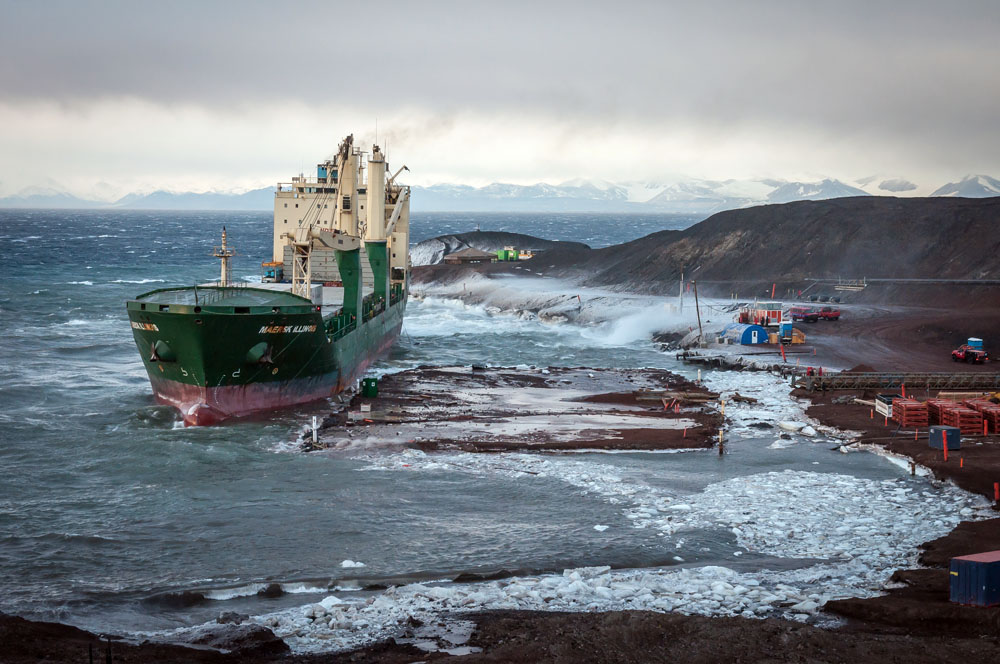
Photo Credit: August Allen
The ice pier deteriorates during a storm at McMurdo Station while the cargo vessel was docked earlier this year.
Construction of the pier takes place midwinter when the temperatures are coldest. Seawater is pumped to the surface and frozen in layers until the pier reaches a thickness of approximately 10 feet. This will keep it solidly in place as the ice around it melts next summer. All work and no play makes for a dull winterover. So, to break up the monotony of the long month, residents organized an evening of wine tasting. Unearthing new wines from McMurdo’s beverage stockroom and the storehouse at Scott Base McMurdo residents ushered out the month of May paying tribute to our nation’s fallen soldiers with a Memorial Day celebration. The station’s main hallway became the center for Memorial Day facts and history, along with photos recognizing the service of residents and their families, both past and present. At 10 a.m. on Memorial Day, a working holiday here on station, people gathered to lower the U.S. flag that flies year-round over the station as Taps was played. After a few words from station management, the ceremony moved indoors for cake and coffee. While light in the pomp and circumstance, Memorial Day is still a sacred day in a place that was built on the hard work and dedication of our military men and women. Winter crew addresses Pegasus Airfield damage from summerMay 23, 2014
Photo Credit: Curtis Harry/Antarctic Photo Library
An LC-130 lands at Pegasus Airfield during the summer.
April was a fairly quiet month at McMurdo Station The last sunset of the season took place on April 24 .The sun rose at 12:06 pm and then set for the final time at 1:35 pm. This was the last time we’ll see the sun until it rises again on Aug. 19. While the weather on the 24th was cloudy and windy, a group of about 70 winter-overs was able to make a trip out to the McMurdo Ice Shelf the day before to say a final farewell to summer light. Piled into Ivan the Terrabus, a large people-transporter with gigantic tires for travelling over ice and snow, residents were bussed out to the Pegasus Airfield Due to McMurdo’s location, set at sea level surrounded by hills, the ice shelf was the only vantage point for seeing the sun during its last month in the sky. Before returning to station, these sun worshipers also made a stop to visit the remains of the C-121 “Pegasus” aircraft, which crashed there in 1970. While there were no injuries, the plane was lost; its remains are now partially entombed in snow and ice. It serves as the namesake for the current airfield used each summer. To make up for the loss of a daily dose of vitamin D, the McMurdo light room was opened to the public this month as well. Set up in an unused dorm room in Building 155, which also houses the cafeteria and the store, the light room is a peaceful setting of couches and chairs that is equipped with light fixtures with full spectrum bulbs. This serves as an alternative for the natural sunlight that will be missing from our lives over the next four months. A volunteer delegation of Americans also made the trip over the hill to the New Zealand base on April 25 to participate in their ANZAC day celebration. The New Zealand Memorial Day honors Kiwi and Australian soldiers lost in battle. Faced with biting wind chills, the ceremony, which included bugling and bagpipes, took place indoors, with a few Scott Base The biggest hustle and bustle of April took place far from station back at Pegasus Airfield, which was severely damaged during the austral summer from a mix of warm temperatures, intense solar radiation and dirt blown over from Black Island. Since then, the Fleet Operations department has been working tirelessly, as long as weather conditions allow, to bring the air strip, as well as the area surrounding the support buildings, back up to operational specifications. Working against the setting sun and the loss of good working light, the small fleet of heavy equipment operators has made daily trips along the 13-mile snow road to fill in deep sink holes caused by melt pools and to smooth and compact the surface of the ice so it is ready to receive the next flights, scheduled for mid-August. By the end of the April the finish line was in sight, and they hope to complete this arduous project by the end of May. Winter begins with a flurry of safety preparationsApril 24, 2014
In terms of daily station operations, the month of March at McMurdo Station With the station almost to its winter population size at the start of the month, departments had to work double duty to cover final flight operations. With shifting weather and flight crew availability, U.S. Antarctic Program Thanks to the flexibility and hard work from many different work centers, the final flight of the summer season took off on March 9, leaving behind a winter population of 142 people to carry on station operations until the next scheduled flight, likely in late August. 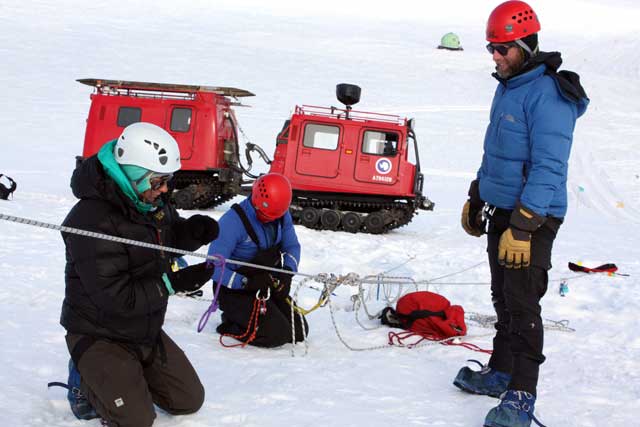
Photo Credit: Jonathan Hollis
Members of the McMurdo Station winter SAR team train during the summer season.
There was still plenty to keep people busy, as the winter staff prepared and organized for the onset of the winter season. On March 15, everyone on station turned out for what is affectionately referred to as “daisy picking,” an all-station outdoor clean-up that gathers up loose items around town, as well as secures and organizes outside storage areas in preparation for winter storms. The effort also ensures that all travel paths are clear and defined, and secures items that could blow away and cause damage to people or property during the dark days of winter. Further safety measures were put in place as everyone completed the mandatory Winter Survival Training and Outdoor Safety Lecture courses. These programs are designed to define and highlight the hazards of working and playing outside in Antarctica. The courses teach skills such as recognizing signs of hypothermia; using radio communications for keeping in touch with the firehouse during work or recreational travel; setting up tents and building wind berms out of snow; and using the contents of survival bags that accompany anyone travelling away from station for work purposes. With safety always on the forefront of all station activity, dorm evacuations and fire drills were held to familiarize all residents with muster points and accountability plans in case of a fire emergency. The medical team also issued a skills assessment survey to gauge various skill sets in case of a mass casualty incident (MCI). With a skeleton crew on station over the winter, any medical emergency with multiple injuries could overwhelm the medical and firehouse staff, requiring the aid of trained volunteers to complete a range of tasks, from transportation and stretcher bearers to assisting with patient first aid and care. [See previous article — Trauma training: Volunteers supplement McMurdo Station's medical staff in emergencies.] An auxiliary medical team, complete with recorders to track patient symptoms and treatment, was selected based on people’s prior education and skills. Group training sessions began to familiarize team members with the medical facility, the MCI plan and each person’s particular role in the event of an emergency. Even with all the training and preparation, life has begun to slow down into a steady winter rhythm. Buildings that have been vacated by summer staff have gone cold and been winterized; unused equipment has been shut down and gone silent; and the once bustling roads on station now harbor only the occasional piece of large equipment. With days getting steadily shorter and the darkness creeping in, the winter staff can now get down to the business of maintaining the station through the long winter months, as we prepare for another busy summer science season that will be here before we know it. February storm causes operational scramble at McMurdo StationMarch 21, 2014
February was a hectic month at McMurdo Station Following the arrival of the U.S. Coast Guard cutter Polar Star Battling poor weather conditions and a deteriorating ice pier that had already been weakened by erosion caused by extreme wave action, personnel scrambled to unload the ship during 24-hour offload operations. 
Photo Credit: August Allen
A storm in February lashes the cargo ship MAERSK ILLINOIS while it is tied up at the McMurdo Station ice pier, which eventually broke into a half-dozen pieces due to the increased wave action.
While all the cargo was successfully removed from the ship, personnel were unable to load more than 100 shipping containers that had been slated to leave with the ship, as a strong wind storm moved in and halted all operations, eventually causing the ice pier to break apart. [See related article — Harsh continent: Storms and waves batter McMurdo Station due to absence of sea ice.] The shipping containers held everything from station waste to scientific samples and had to be dealt with accordingly after the Illinois managed to depart station on Feb. 9. That left station leadership scrambling to find room in the dwindling flight schedule to deliver important scientific samples to their destination by air, while the rest of the containers were stored to wait until next year’s vessel operations. The same storm wreaking havoc on vessel offload also caused a brief moment of uneasiness when it was discovered that the high wave action was causing the ground beneath the seawater intake pumps at the water intake jetty to deteriorate. 
Photo Credit: Jack Green/Antarctic Photo Library
An LC-130 prepares to take off from Pegasus Airfield skiway in January 2014.
These pumps provide all the seawater that is used to make the station’s water supply by filtering it using reverse osmosis. Station personnel leapt into action to set up a temporary intake line so that heavy equipment could be brought in to bolster the jetty. Quick thinking and hard work paid off, and the permanent pumps were back in operation within a week. While folks dealt with these issues on the water, others were fighting a never-ending battle with conditions at the Pegasus Airfield Though weather conditions made it difficult, the long hours paid off, with the successful end to the season. South Pole Station was fully fueled for the winter, and flight operations managed to continue through the end of the month. Those final flights of February carried in most of the remaining winter-overs, even as the station population shrank dramatically with each departing flight. Starting the month with almost 1,000 people, there were a scant 200 as February came to a close. The last flight of the 2013-14 season at McMurdo was on March 9, leaving a population of 142 people for the coming winter. Hopefully, Mother Nature is a little kinder than she was over the summer. Visitors aplenty in January, from tourists to journalists to wildlifeFebruary 28, 2014
January was a busy month at McMurdo Station Tim Bisbee, the new winter site manager for McMurdo Station, arrived in January. As a new addition to the McMurdo team, he will spend the month or so leading up to the winter familiarizing himself with the station and turning over operations from the current summer management. 
Photo Credit: Jack Green/Antarctic Photo Library
An LC-130 prepares to take off from Pegasus Airfield.
Science field camp activity reached a peak early in the month with 126 people working at 21 camps across the continent. The science traverse across the Ross Ice Shelf to deliver a drill for the Whillans Ice Stream Subglacial Access Research Drilling (WISSARD) The McMurdo Dry Valleys LC-130 Earlier delays due to weather and mechanical issues meant flight operations were increased to a frenzied 24-hour pace to make sure that all operations, particularly refueling South Pole Station, were complete before the Air Guard crews returned home. The flight crews also continued to provide airlift between McMurdo and Christchurch, New Zealand. The skies weren’t the only busy thoroughfare in January. The U.S. Coast Guard cutter Polar Star 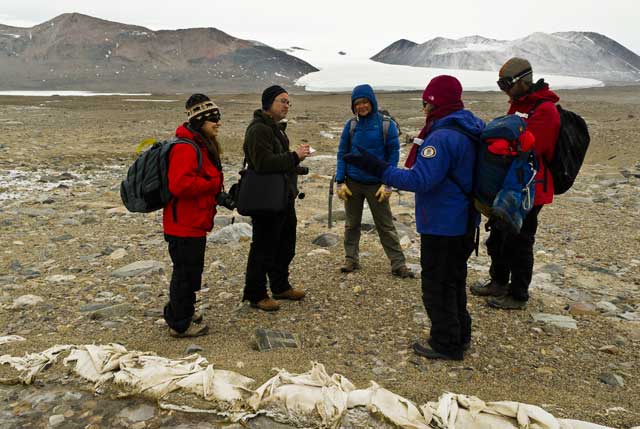
Photo Credit: Peter Rejcek
Time for Kids science writer David Bjerklie, second from left, interviews scientists in the McMurdo Dry Valleys.
Favorable, strong winds assisted in the ice movement, and McMurdo Sound quickly cleared of all ice, leaving in its wake lapping waves and increased wildlife activity. Minke and killer whale sightings became a frequent event from nearly every work center window. The open water also cleared the way for a brief window of opportunity for cruise ships to visit station, and volunteer tour guides hosted approximately 360 visitors from the five Antarctic pleasure ships that visited the harbor. Finally, McMurdo also played host to a visiting reporter, as David Bjerklie, a science journalist for Time Magazine’s Time for Kids publication, spent 10 days visiting. Time for Kids is a weekly classroom news magazine, and this month it featured National Science Foundation McMurdo Station stays on the move in DecemberJanuary 17, 2014
As the last of the summer stragglers trickled in to fill spots left open after October’s partial government shutdown, operations in McMurdo Station December was a busy month for cross-continent travel, with multiple traverse teams crossing the ice. The South Pole Traverse (SPoT), a train of tractors that pull sleds carrying fuel bladders, had two caravans in operation across a thousand miles of Antarctica. SPoT1 returned to station on Dec. 29, after delivering about 96,000 gallons of fuel to South Pole Station 
Photo Credit: David Weimer/www.beyondthebackyard.com
The first South Pole Traverse makes its way down the Leverett Glacier in December.
The 220,000 gallons of fuel delivered by these two traverses was the equivalent of about 60 LC-130 A different sort of tractor train left McMurdo Station on New Year’s Eve. The “light” traverse team left station en route to a field camp at the edge of the Transantarctic Mountains, approximately 650 miles south of McMurdo Station, in support of the Whillans Ice Stream Subglacial Access Research Drilling (WISSARD) Last year, researchers with WISSARD drilled into a subglacial lake through about a half-mile of ice where they collected water and other samples, discovering life in that extreme environment. This year’s study will focus on geophysics experiments that will image the lake, including drilling holes in the ice sheet and deploying instruments inside. The traverse carries all the drilling supplies that will be needed to complete this year’s activities. Folks work six days a week, and with a round-the-clock operation, everyone takes advantage of recreation when possible. There are daily and weekly options for activities – from yoga to basketball – but some of the most notable were those focused on outdoor adventures. Taking advantage of the good weather, volunteer tour guides offered almost daily trips to traverse the pressure ridges along the ice shelf-sea ice transition. These pressure ridges, located near New Zealand’s Scott Base 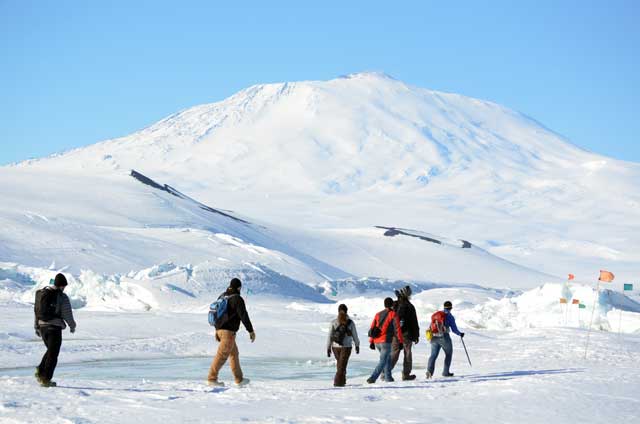
Photo Credit: Peter Rejcek
McMurdo Station residents tour pressure ridges in the shadow of Mount Erebus.
The holiday season was a festive time on station, with many people contributing to a feeling of holiday cheer despite being separated from family and friends. Kitchen staff and volunteers worked hard to decorate the dining area with garland, snowflakes and other handmade crafts to bring a touch of home to this faraway place. For the more musically inclined, a Christmas choir was convened, with rehearsals over the weeks leading up to Christmas Eve, when a recital of classic tunes was held to kick off the annual Christmas party held at the Vehicle Maintenance Facility. Santa Claus even made a special appearance for photos and holiday greetings. On Christmas morning, there was a race up Observation Hill, the highest local peak, looming 750 feet over station, for those inclined to make the grueling trek. Male winner Trevor Layman reached the peak in 7:01 with female winner Sarah Kernasovskiy not far behind at 9:25. One of the highlights each Christmas is the lavish holiday dinner, and this year was no different. Beginning preparations two weeks prior to the big day, the kitchen staff, with the help of many eager volunteers, prepared five full Christmas dinners. This encompassed multiple seatings throughout the day and night to cover all shift workers. According to kitchen steward Shannon Keller, McMurdo residents ate 600 pounds of prime rib and 400 pounds of lobster tail, 75 pounds of broccoli and 440 pounds of potatoes – and that doesn’t take into account the 160 pounds of potatoes used to make gnocchi. For those with a sweet tooth, 135 assorted cakes, tarts, torts and Bundt cakes were consumed, along with 800 cookies and more than 1,000 hand-dipped truffles. Topping off this massive feast was 140 pounds of fudge and 20 gallons of egg nog. 
Photo Credit: Peter Rejcek
The 25th anniversary of the music concert known as Icestock took place on Dec. 31.
That’s enough to kick-start anyone’s New Year’s resolutions! Speaking of New Year’s: Holiday festivities wrapped up with the 25th annual Icestock performance on Dec. 31. This outdoor music festival featured 12 bands playing more than seven hours of music. As the musicians rocked in the New Year, others battled it out to reign champion in a chili cook-off competition. Beautiful sunny skies and calm weather made this year’s event all the merrier as McMurdo residents rung in 2014. Although summer activities are still ongoing, we are already looking ahead to the hand off of the station between the summer and winter crews. In December, the winter-over Search and Rescue Team (SAR) was selected from a pool of applicants, and the new team began training. The SAR team is responsible for rescue activities in the case of missing or injured personnel, both on the job and during recreational travel. They also work as escorts for personnel movement during severe storms. They train weekly throughout the year and work jointly with the New Zealand SAR team to provide a safety net for all Ross Island personnel over the winter. Training began with sea ice profiling, which taught team members how to safely and accurately profile ice depth and crack safety when travelling over the sea ice. This will be useful in rescue operations, and will also be utilized at the end of the winter when setting travel routes to scientific sites such as Cape Royds and Cape Evans. |
Home /
Around the Continent /
McMurdo Station Archives - 2014
"News about the USAP, the Ice, and the People"



For USAP Participants |
For The Public |
For Researchers and EducatorsContact UsNational Science FoundationOffice of Polar Programs Geosciences Directorate 2415 Eisenhower Avenue, Suite W7100 Alexandria, VA 22314 Sign up for the NSF Office of Polar Programs newsletter and events. Feedback Form |


